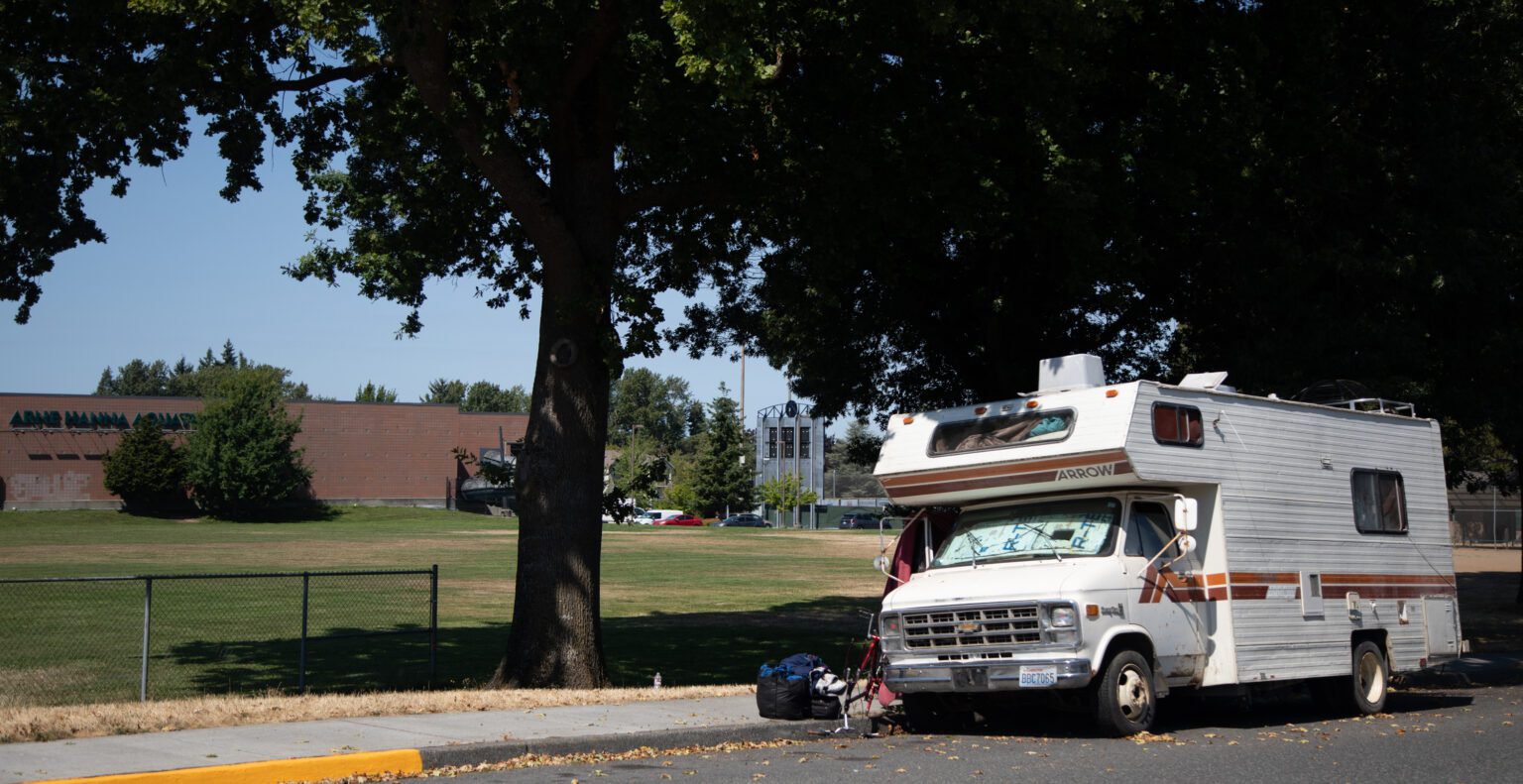Bellingham schools and child care facilities are the latest battleground in the city’s fight to combat rising homelessness, drug addiction and community safety.
With more homeless individuals turning to recreational vehicles, tents and cars for shelter, city leaders want to curb “erratic behaviors” around encampments — particularly those near youth facilities and recreational areas.
While business owners and leaders at local children’s organizations are concerned about safety, people living in RVs worry about where they’ll go if — and when — they’re forced to relocate.

But so far, proposed solutions have been sent back to the drawing board.
Already, city leaders are rethinking a recent proposal that sought to prohibit RV parking within 1,000 feet of the perimeter of schools, playgrounds, recreational facilities, public parks, libraries and public transit centers, among other locations.
That proposal was spurred by complaints from residents and employees at local youth centers, including leaders at Bellingham’s Boys & Girls Club (B&G) concerned with “poor behaviors,” Bellingham Mayor Seth Fleetwood said during a Monday, Aug. 14 city council meeting.
Those behaviors include domestic violence disputes, public urination, drug use, crime and “buckets of feces” on the sidewalk leading to the B&G clubhouse on Kentucky Street, B&G Clubs of Whatcom County CEO Heather Powell said Tuesday.
“We need to make sure when children approach this place, when they’re in this place, they feel safe,” Powell said inside the clubhouse where children were reading books and playing games. “What we are seeing is that Kentucky Street is not conducive to safe places for kids, so we asked for a tool that we defaulted to because something does need to change. Something needs to be done.”
Powell said the request for a 1,000-foot perimeter was “in no way meant to be a condemnation of people who are houseless,” or people currently living in RVs “trying to be good neighbors,” but said the safety of children was her priority.

For Brandon Edwards, 36, and his fiancee Annie Malm, a 1,000-foot perimeter would dramatically limit available parking spaces for their RV, which they’ve lived in since their house burnt down in June this year.
They’ve stationed their borrowed RV near a park in downtown Bellingham — meaning they’ll have to relocate if the city mandates a 1,000-foot perimeter.
“We already have to move every 72 hours,” Edwards said while sweeping the street behind his RV. “We’re doing everything we can right now to find a place to live in, but we have to move every 72 hours. Where else can we go?”
Edwards and Malm expressed support for a perimeter ordinance around schools and child care facilities, but said including parks and recreational areas would make their lives significantly harder.
“It’s like they’re treating us like sex offenders or drug addicts,” Malm, 40, said while feeding the couple’s two dogs. “We didn’t ask for this. We got put in this situation where we lost everything.”
People camped within 1,000 feet of Carl Cozier Elementary School and the Arne Hanna Aquatic Center voiced similar concerns.

Levi Dudley, who said he lost his home and his car after a fight with cancer — currently in remission — and some scrapes with law enforcement, has been working with the Law Enforcement Assisted Diversion (LEAD) program and case workers to try to find a new place to live.
“I’m a sober, single father in remission, and I don’t have a job, a car, an address, even a refrigerator,” said Dudley, 35. “The shelters are full. Where else can I go?”
The city already has enforcement codes related to RV parking, though the language in the code is less specific, and only applies to vehicles on public streets above a certain width.
Currently, there’s a prohibition on parking vehicles wider than 80 inches on any city street, except for those in manufacturing and industrial-zoned areas in the city — including the streets where the B&G clubhouse is located.
Powell said other clubhouses in Whatcom County, including the Lynden, Blaine and Ferndale locations, don’t experience challenges with RV parkers.
But, she said, attendees at two of the four B&G-operated early learning centers in Bellingham — one on Sunset Drive and the other on Northwest Avenue — have also seen drug-related and behavioral challenges.
“That’s why I’m not just advocating for us to address something solely on Kentucky Street,” she added. “We need to be having conversations not just about how to protect kids coming to the clubhouse or early learning centers. We need to think about the kids who are at Carl Cozier and other places where kids deserve to feel safe.”

Carl Cozier, one of 14 elementary schools in the Bellingham Public Schools district, has been the subject of concern in recent years as homeless and RV encampments pop up near school grounds and at the Arne Hanna Aquatic Center next door — where one person has died from a drug overdose this year.
Parents of Carl Cozier students have reported unsafe conditions, school lockdowns, used drug paraphernalia and other concerns around the Lincoln Street school. To help combat that, the school district installed a fence around school grounds.
“We have empathy for all those in our community experiencing housing insecurity or homelessness, and we also prioritize the safety of our students,” said Dana Smith, the district’s assistant director of communications. “We will also continue to do everything within our sphere of responsibility to ensure that our students, staff and visitors are safe while on our campuses.”
Smith said the school district was still learning more about the proposed code change, and supported the city’s work to “address safety and security, especially in places where children travel to and from school, learn and play.”
While the city considers alternatives to the initial 1,000-foot proposal, staffers are also exploring the creation of a safe parking program, which would create a managed space for individuals who reside in vehicles — not just RVs — to park without risk of being towed.
“We’ve put in substantial effort in trying to identify locations and also consideration of operators,” Fleetwood said July 24. “I know interest in creating a safe parking program is something that has been on the minds of a number of us.”




